The Development of the Steam Locomotive in Russia
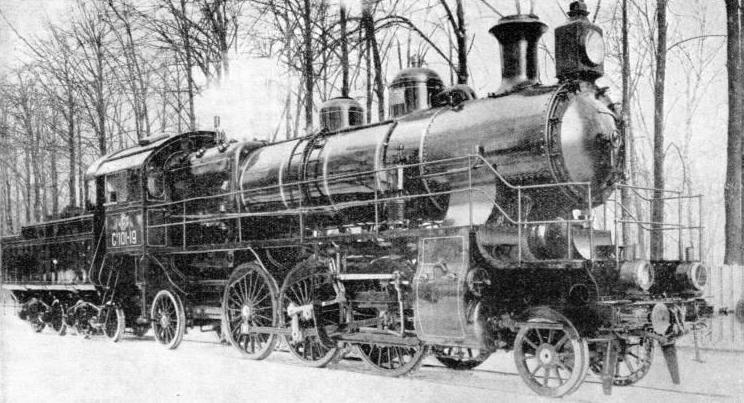
One of the most striking features about Russian engines is their unusual height. They are 17 ft from rail to chimney top. The biggest British engines are 13 ft 6 in high. This photograph shows a standard 2-6-2 express locomotive, built for the Russian 5ft gauge.
RUSSIAN steam locomotive construction began in 1833 and suddenly finished in 1956, and you would have to travel a long way in that country today to see surviving steam in any numbers. And yet as recently as 1958, over 70 per cent of all Russian rail traffic was operated by steam locomotives, of which 36,000 were still at work.
It is not always realised that the Russian railway system is the largest in the world under one administration. The distances are enormous, over six thousand miles from the Polish border to Vladivostok on the Pacific ocean. About 1,300 miles north of Moscow, the rails lead to the icy tundra above the Arctic Circle, while a like number of miles south they reach semi-tropical conditions on the Persian border.
It could be imagined that the steam engines operating this vast system must have been dramatically large and powerful, bearing in mind that a rudimentary trunk road system and frozen waterways in winter ensured that 80 per cent of all the nation's traffic was carried on rail. Not so however, for chronic shortage of funds in Tsarist days, and the overriding diversion of resources to heavy industry and defence since then, have persistently held down the strength of track and size of locomotives to smaller proportions than has been the case in that other railway giant, the United States of America. Moreover, with so much of industry dependent on the railways, with the long distances and the severe climate, reliability is absolutely essential and this, combined with the relatively sparse technical background of the mass of the people, has led to extreme conservatism in motive power design, so that in all periods the Russian steam locomotive has tended to be simple, robust, and largely derivative of practice elsewhere.
There have been three overlapping phases of development, the first up to the eighteen-seventies when foreign firms - British, French, Belgian, German and American - built the earliest lines and provided much of the motive power, which existed in luxuriant variety. In the second phase, which lasted until 1928, Russian design and construction became general and with the nationalisation of the formerly private lines, standard engine designs were introduced which could be built in large numbers for universal use. Indeed, limitation in variety and huge numbers in each engine class became from that time a distinguishing feature of Russian practice. A last phase starting with Stalin’s first Five Year Plan introduced higher axle loads and bigger locomotives. From that point onwards design followed American practice closely, an interesting point having regard to the idealogical differences between the two countries.
Of the countries which supplied the engines in the opening phase, Britain was the first whose engines were put to commercial use, starting with Hawthorn’s 2-2-0 for the pioneer St Petersburg to Tsarkoe Selo line of 1837. Thereafter, for the next forty years a variety of firms supplied 2-4-0, 4-4-0, 0-6-0 and 0-4-2 engines of modest proportions and very British design. One and all they had to survive the horrific Russian winter, and whereas they were at first supplied with normal equipment as used at home, it was only gradually through a long vale of tears that modifications were introduced to meet the demands of the climate, such as enclosed cabs, unfreezable injectors and brake equipment, and means to keep oil in a fluid state - oil which left to itself froze to the consistency of soap! Weatherburn, writing in the Railway Magazine in 1913, gave a graphic account of his experiences at the turn of the century as engineer in charge of putting Kitson engines to work, often in mid-winter in the most primitive conditions. In the course of the work he had more than one hair-raising encounter with wolves and experienced to the full the hard conditions which obtained in the countryside outside the big cities.
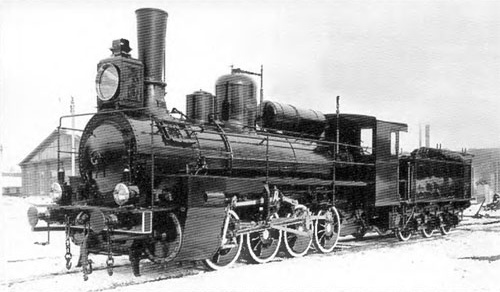
Class O 0-8-0, built between 1891 and 1923.
In those same years, besides imports from other countries, a modest Russian industry grew up manufacturing locomotives of very similar shapes and sizes, and an interesting sideline of the early days arose from a visit in 1870 of Count Bobrinski, a favourite of the reigning Tsar, to the Duke of Devonshire at Chatsworth. Together they visited Portmadoc and saw Fairlie’s double-bogie engine Little Wonder at work on the Festiniog Railway. The encounter led to introduction of the type into Russia and, besides subsequent imports, a number were constructed locally, survivors of which were working in the Caucasus area as recently as 1936.
In that period also was established an external feature which, almost more than anything else, indelibly stamped an engine as truly Russian, namely the set of railings round the outside of the running platforms. Introduced by Imperial decree in 1870, their purpose was to give protection to the engine crew from falling off the slippery surfaces when iced over, a thoughtfulness towards the workers hardly typical of Tsarist times. The railings remained on the engines to which they were fitted until the end of steam, but their application was discontinued after 1928 on the larger American-type locomotives of the Stalin era, and on some of the later versions of purely Russian types as well.
The interruption of imports during the Russo-Turkish war of 1878 underlined the deficiencies of dependence upon foreign suppliers; there was initiated from that time a policy of gradual absorption of the privately owned railways by the State, accompanied by a large increase in domestic locomotive-building capacity. At the same time, to ease the problems of manufacture and repair, a big reduction was made in the riotous variety of designs which had been allowed to develop, and
new construction was henceforth intended to be confined to a very small number of types which could be built in quantity for universal use.
In a country so industrially backward as Russia was then such a radical policy was unable to be introduced all at once, and in the next 35 years, besides a few classes built in really big numbers, there appeared also some more tentative designs which failed to proliferate to the same extent. On the passenger side 4-4-0s continued to be built until the end of the century, many in the form of tandem compounds. They were followed by several designs of 4-6-0, often with outside Joy’s valve gear. The first of the really large-scale standard types was a two-cylinder 2-6-0 (class N) of which about a thousand were built between 1892 and 1913. Not yet however was standardisation of detail achievable, and there were no fewer than thirteen sub-variants having wheels between 5 ft 7-in and 6 ft 3-in diameter and axleloads between 14½ and 16 tons.
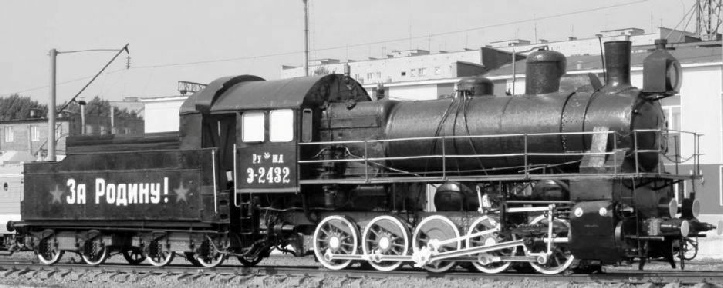
Class E 0-10-0, built between 1912 and 1952.
The second standard was a two-cylinder 2-6-2 (class S) having 6 ft coupled wheels, which was the most widespread and successful passenger engine ever built in Russia. The first 900 engines turned out between 1910 and 1918 had cylinders 21⅝-in by 27 9/16-in, a working pressure of 185 lb per sq in, a grate area of 41 sq ft and an axle load of 15.8 tons. In its basic concept this class was to continue in production over a period of 40 years, with progressive developments in design, until the last of nearly 4,000 machines was completed in 1951 having cylinders 22⅝-in by 27 9/16-in, grate area 50.9 sq ft and axle weight 20 tons.
On the freight side, there were two designs, the Class O 0-8-0 built between 1891 and 1923 and the Class E 0-10-0 between 1912 and 1952, which became numerically the largest classes ever to appear on the world’s railways, reaching totals of the order of 9,000 and 13,000 respectively (a combined total greater than the whole stock of locomotives on British Railways at the time of nationalisation, when 448 different classes existed). Although in the standard freight types also there have been detail developments through the years, the general size and appearances has remained remarkably uniform. The 0-8-0 had cylinders 19 11/16-in by 25 9/16-in, coupled wheels 3 ft 11¼-in in diameter, boiler pressure varying in different series from 156 to 213 lb per sq in, grate area 19.9 sq ft and axle load 13½-14 tons. The 0-10-0 had cylinders 25 9/16-in by 27 9/16-in, 4 ft 4-in coupled wheels, boiler pressure 171 to 191 lb per sq in, grate area 48 to 54.7 sq ft and axle weight 16.7 to 17.5 tons. Both classes have tackled every kind of traffic during their long lives. Since 1945 the Class E has been built in almost every satellite country as well as in Russia itself.
Another large class of almost identical dimensions to the Class E was a purely American design of 2-10-0 ordered in 1915 to 1917 in the last days of the Tsarist regime (Class Y). About 900 of the engines were delivered from US West Coast ports
to Vladivostok and became the predominant freight type on the far eastern lines. As an example of Russian conservatism, even under the Soviets, 2,100 more to the same design were delivered from the USA to the same port under Lend-Lease during the second world war; they joined their forebears of 30 years earlier in continuing to power the far-flung lines of Asiatic Russia.
Besides these vast classes, smaller groups of 2-8-0 engines were built in the earlier years of the century, as were about 450 2-4-4-0 and 0-6-6-0 Mallet compounds constructed between 1903 and 1916 for working on the Trans-Siberian Railway. Designed and built in Russia the 0-6-6-0s were very ungainly looking machines which finished their lives in Central Asia.
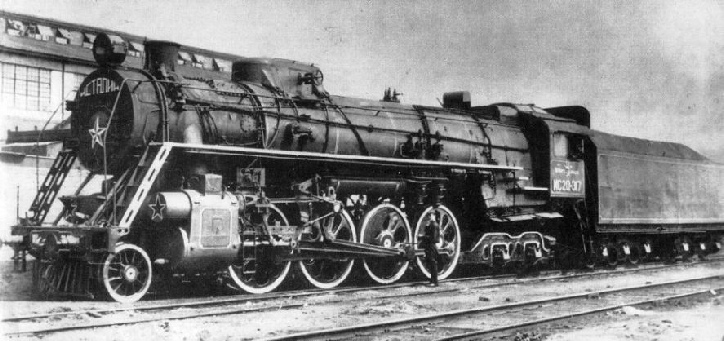
Class IS 2-8-4 passenger engine, a type first built in 1932 with many American features, with “J. Stalin” carried on the smokebox door.
The 1914-18 war and subsequent revolution, saw a great thinning out of the older classes, and a serious shortage of available power. The domestic locomotive works were inert due to lack of materials and in desperation the Soviets ordered in 1920 700 of the E-class 0-10-0s from a consortium of German builders and 500 more from a Swedish firm. Home building was resumed in the mid-twenties and both the E class plus the S class 2-6-2 continued to multiply. Somewhat later another design appeared, the SO-class 2-10-0, which was the last of what might be termed purely Russian products. Except for the leading truck, the design, including cylinders, wheels and underframes, was identical with the later series of 0-10-0s but the boiler was bigger with a grate area of 64.5 sq ft. Axle load was 17½ tons. Something like 5,000 SO-class engines were built, some of them in new workshops set up in Siberia during the German invasion.
Apart from the continued building of the purely Russian classes outlined above, and apart from some interesting experimental types acquired only in ones and twos, only five more new designs were produced in the period 1928 to 1956, two of them between the wars, and three more after 1945. Nevertheless, true to the policy of big numbers, Russian workshops produced over 9,000 units of these five classes before the end of steam.
In the first Five Year Plan that started in 1928, the decision was taken to upgrade railway power and important trunk routes were relaid to take a 20-ton axle load. Much influenced by the design and performance of a small number of 2-10-2 and 2-10-4 engines which had been purchased in the USA when resources began to become available after the revolution, the Soviet administration in 1931 produced the FD class of 2-10-2 freight engine and in 1932 the corresponding IS class of 2-8-4 passenger engine. The two classes had an identical boiler carrying 213 lb per sq in pressure and 75¾ sq ft grate area. Cylinders were 26⅝-in by 30 3/16-in and the engines alone weighed 135 and 134 tons respectively. Construction of these classes ceased when Russia was drawn into the 1939-45 war, by which time 3,200 Class FD and 650 Class IS engines had been built.
In the post-war devastation, new building had perforce to be concentrated upon engines which could run anywhere, and in the three final Russian steam designs axle loading was restricted to 18 tons. The first was a modernised 2-10-0, Class L, also called the “Victory” type. Originating in 1945, it was thoroughly American in layout; details were: cylinders 25 9/16-in by 31½-in, wheels 4 ft 11-in diameter, pressure 199 lb per sq in, grate area 64½ sq ft and engine weight 104 tons. It proved to be a most successful and versatile type, of which almost 5,000 were constructed in 12 years.
Second in importance of the post-war types, introduced in 1950, was a 4-8-4 passenger engine, Class P36; like all modern Russian construction, it was a straightforward two-cylinder design. Although conforming to the required 18-ton axle loading and weighing 135 tons, it was also in essence truly American, having roller bearings throughout, Boxpok wheels and mechanical stoker. Only the fairing along the boiler top and its rather ornate appearance at the front end, betrayed its Russian origin. Its main features were cylinders 22⅝-in by 31½-in, wheels 6 ft 0¾-in, pressure 213 lb per sq in and grate area 72.6 sq ft. Around 250 P36 engines worked mainly on the Moscow-Leningrad and Moscow-Polish frontier lines before the change in motive power.
Thirdly, there was Class LV, an elongated version of the Class L in the form of a 2-10-2, identical except in having a larger grate. Begun in 1952, only about 100 had been built before the ukase to end steam construction was issued in 1956.
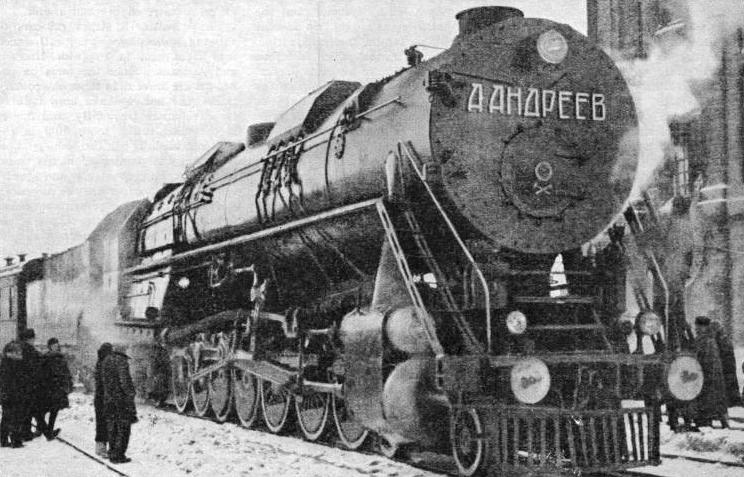
Europe’s most powerful goods engine. This is the claim made for the large 4-14-4 freight engine, seen here on its arrival in Moscow in January, 1935. It was designed for hauling coal trains of 3,000 tons from the Donetz mines to Moscow.
Space forbids description of the fascinating “one-offs”, the experimental types which had no aftermath. Of them, there was the legendary 4-14-4 engine of 1934 which could not be induced to stay on the road; the Beyer Peacock-built Garratt of 1932, lost without trace in the wilds of Siberia; and the 2-8-8-4 simple-expansion Mallet Class P38, of which two prototypes were built in 1955. The last-named were the heaviest locomotives ever to have been built in Russia, but even so, at 215 tons engine weight they totalled only 60 per cent of the weight of locomotives of similar wheel arrangement in North America.
The need for total reliability meant that the Russian steam locomotive was well looked after. Immaculate, the passenger engines in bright green and the freighters in gleaming black, they were frequently embellished with emblems on smokebox door and cab or tender sides, as on the old Scottish Caledonian railway, which indicated the pride of the footplate crews.
Measuring over 17 feet to the chimney top, four feet higher than the largest British engine, and with boiler centres pitched as high as 11 feet, the modern Russian engine was awe-inspiring close-to; the typical rather soft sound of its exhaust was counterbalanced by the raucous blast of the enormous chime whistles which they all carried. Two outside cylinders were almost universal, and few have been the multi-cylindered engines in Russian history. Simplicity was all.
The small number of indigenous classes in so large a country was quite astounding. Kremlinologists have only identified 24 classes among the probable total of 36,000 locomotives running in 1958.
Unlike almost every other locomotive-manufacturing country in the world, Russia had a negligible export and its designs had hardly any influence abroad. In 1883 the Societe Russe of St Petersburg built a few 0-6-0 engines for the Andaluces Railway in Spain, and one of them was photographed at Cordoba as recently as 1963 complete with builder’s plate in Russian characters. In 1908 ten locomotives were exported to Roumania, and in recent years, before the idealogical split, an unknown number of FD 2-10-2s were transferred to the Chinese Railways as a gesture of solidarity. Beyond these few cases nothing can be traced.
You can read more on “Moscow’s Underground”, “Russia and Siberia” and “The Trans-Siberian Express” on this website.







